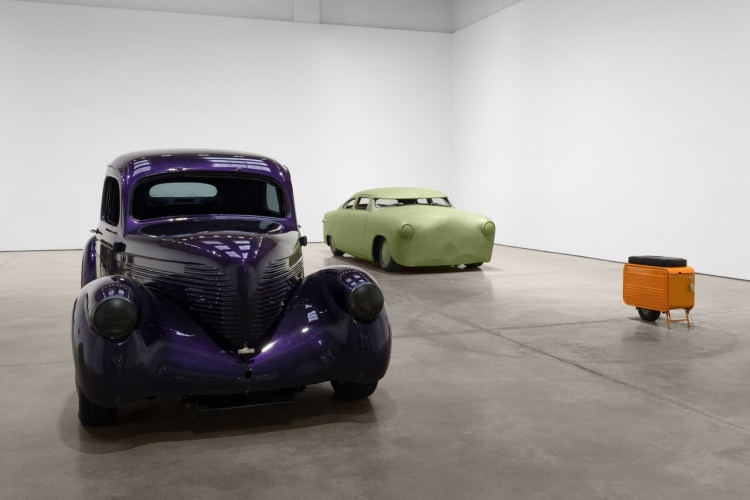
Installation view, Robert Grosvenor, Paula Cooper Gallery, New York, February 15 – March 22, 2025. © Robert Grosvenor. Courtesy Paula Cooper Gallery, New York. Photo: Steven Probert
When is a car not a car? Better put, when does any object lose its identity and become something else? It may be reborn as decoration, or as a fetish imbued with supernatural powers, or, in the case of Robert Grosvenor, metamorphosed into a work of art. There is irony involved in the process, a factor that links Grosvenor—usually identified as a maverick Minimalist—to Pop art. But Grosvenor’s version of Pop art takes objects already fetishized—chopped and channeled classic American cars, the raw material of hot-rodding and customizing—and subjects them to yet another transformation. You can’t drive Grosvenor’s cars; you can only look at them.
Let’s look at Untitled (2022), “automobile and metal.” What was once the dream car for any hot-rodder, a 1930 Chevrolet pick-up truck, chopped and channeled, fitted with a big V-8 engine, has become a memento mori, an elegiac monument. You couldn’t get into the vehicle unless you were a child and even then, you could do nothing with it. It is now a fetish emptied of its power, covered with rust, deliberately uglified—not all the tires are whitewalls—only fit for catching the eye. And what we see is an American version of the cut flowers in a seventeenth-century Dutch still life: death. Our national version of Charon’s ferry, this former vehicle metaphorically, spiritually transports us across our own Styx.
Grosvenor’s fiberglass resin replica Willys Americar (so-called because it was manufactured during the patriotic fervor leading up to America’s entry into World War II) deliberately parodies the customizing frenzy that consumed any remaining Americars, the model now extinct with only simulacra like this available. The hot-rodder’s ideal point of departure, the Willys was originally a cheap copy of the more expensive Fords, that is, born as an imitation. It is as if Grosvenor took the idea of the hot-rod—transform the original Willys by installing a powerful engine—and made instead a very shiny derelict. Deliberately useless, with no windshield but with superfluous goggles on the dashboard, with blacked-out headlights, this former car is going nowhere fast. The slapdash quality of the “improvements,” a deliberate tactic on Grosvenor’s part, thwarted the meticulous care the committed aficionado would expend customizing an old car: it would win no prizes.
The final car is a Ford sedan produced between 1949 and 1951. At first glance, the car resembles the Fords teenagers drove in the later 1950s: hood and trunk ornaments removed, the roofline lowered, the grill replaced. The resemblance stops there. Grosvenor has strived for ghostly anonymity here, so the car is painted in a matte green—a sharp contrast to the glittering Willys—right down to its wheel covers, its headlights, and the space formerly housing the grill. This is a truly dead car painted the green of decay. Without glitziness, the auto is in essence a coffin, a parody of some Viking boat used for burying a warrior. The possibility of rebirth essential to hot-rodders and car customizers—the idea that an old car can be made new again—is thwarted in this Ford and the two other cars here. Nothing remains but the fading memory of someone’s fetishized version of a useless wreck.
And what could be more useless than a boat out of water? Especially a speedboat badly painted turquoise and white, with the same fins that adorned so many cars—especially Cadillacs—during the early 1960s. Like a beached whale, this derelict craft is carrion, a useless tub no good for anything. And of course that is Grosvenor’s point: the Pop concept of taking an object out of its context and isolating it in alien space comes home to roost here coupled with the idea that dead relics of speed and power are only so many tombstones.
Included in the show are eighteen photographs, fourteen of them 4 by 6 inches, and four 30 by 42. As a body, they constitute not a contextualizing of the objects in the gallery but an access point to Grosvenor’s imagination. Some are contrived—a toy boat photographed to look like a real one—and others, snapshots of places that for some reason caught the artist’s fancy. We might think of them as pages in a sketchbook, but instead of quick drawings we have images or preserved memories. Some are poignant—a seashell—others commemorative—a reworked Studebaker that could easily have taken a place in the gallery. Personal, impenetrable, they are paths taken and untaken, esthetic ideas.